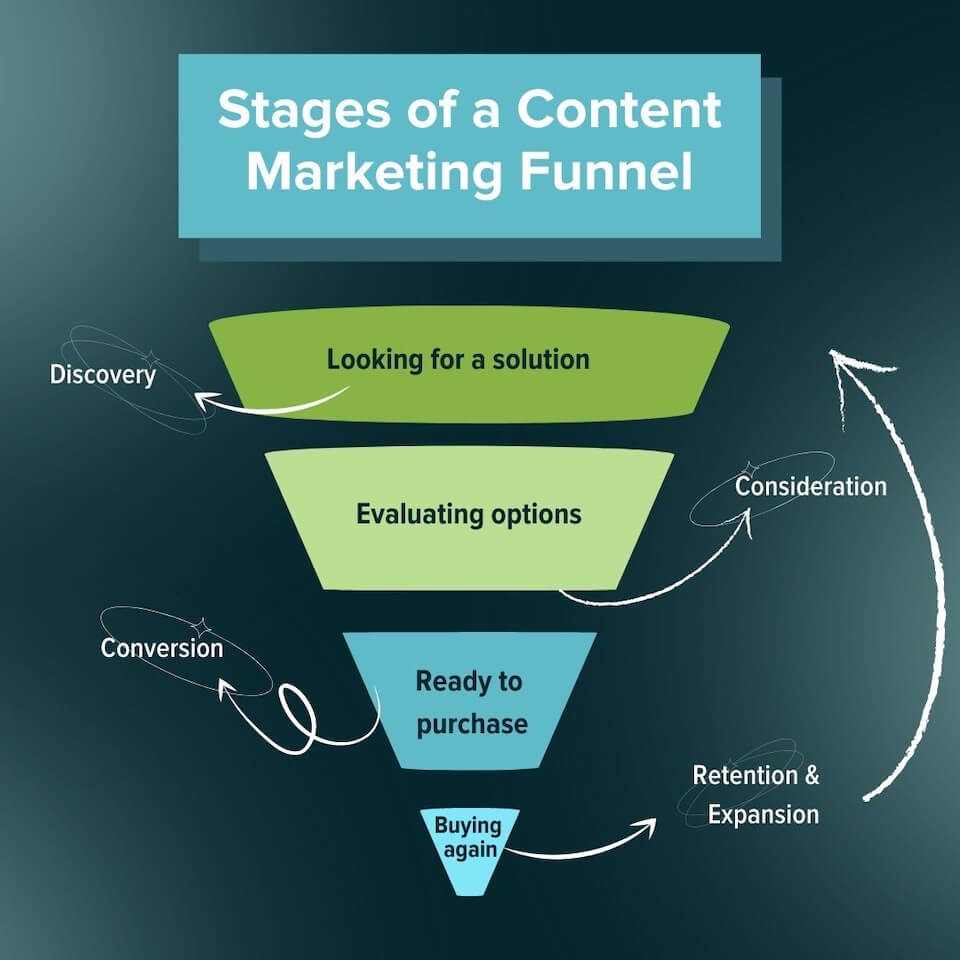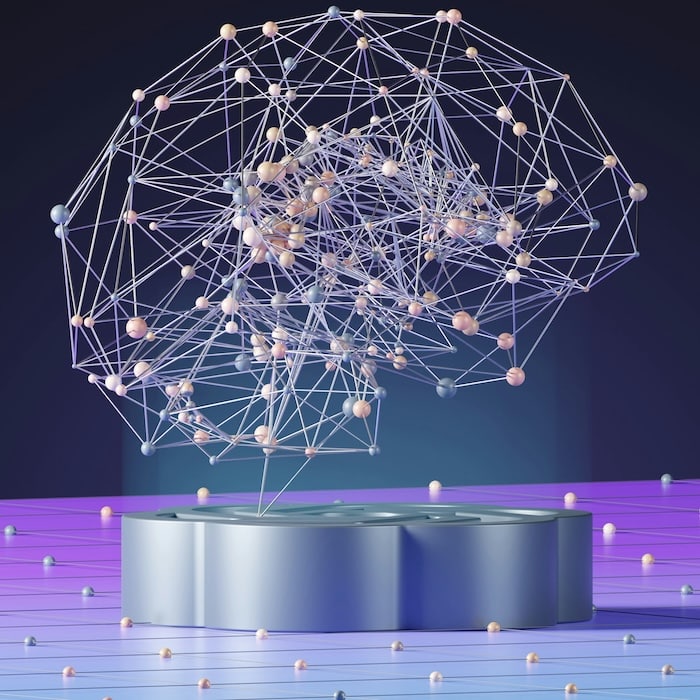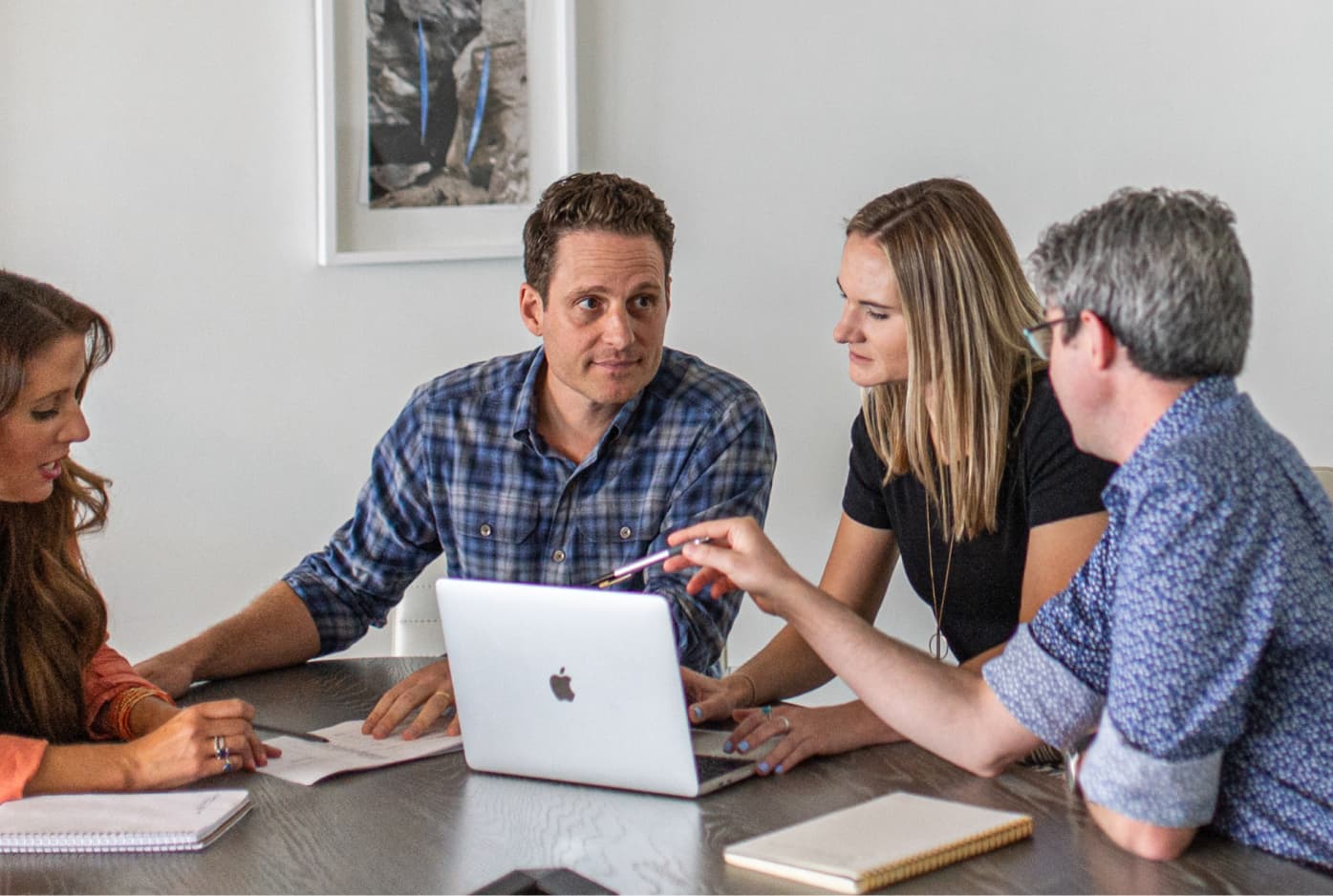
What Is a Conversion Funnel? (How to Optimize Your Funnel)
Sep 18, 2020|Read time: 11 min.
Key Points
- A conversion funnel is a metaphor used to describe the full journey your customer takes as they move from “just browsing” to “Please take my money!”
- It doesn’t make sense to optimize for conversions until you create a conversion funnel.
- Use SEO as the cornerstone of your process as you figure out how to build your conversion funnel.
Have you ever visited a website to read a blog post or browse about a topic, only to be bombarded by sales pitches for a product when you’re nowhere near the buying process in the conversion funnel?
How fast did you leave?
In order to acquire new customers, you need to do more than just increase conversions. To fill your marketing funnel with qualified leads, you need to get the right conversions from the right audience at the right time.
If your marketing strategy is bottom heavy and only focused on the final sale, you’ll miss the opportunity to connect with a large percentage of your audience who may just not be ready to buy right now. As a result, your content marketing will likely underperform.
In other words, it doesn’t make sense to optimize for conversions until you know how to build a conversion funnel. Here’s how to do it.
What is a conversion funnel?
Marketing term
Conversion Funnel
A conversion funnel is a metaphor used to describe the full journey your customer takes from problem aware to purchase. In other words, the conversion funnel describes the journey from curiosity to customer.
Nearly every ecommerce site has a website conversion funnel. However, not all conversion funnels take the same amount of time to complete. A B2C site that sells inexpensive, impulse-friendly products might be able to capture a customer’s interest, introduce them to the brand, and convert them within a single session. More expensive B2C products require more time and consideration. And B2B products or services require time, consideration, and layers of coordination between stakeholders.
For these companies, conversations can last months.
The longer it takes to introduce a customer to the solution, the longer the conversion funnel. The longer the conversion funnel, the more critical lead nurturing becomes.
Conversion funnel stages
To make conversion funnel marketing a bit easier, we visualize different stages based on the customer journey. Sometimes funnel phases have different names or more stages. But most describe a similar path.
The most common phases are: awareness, interest, consideration, decision and retention.
This graphic combines awareness and interest into “discovery.”

Awareness stage
Without the awareness stage of the conversion funnel, you wouldn’t have an audience. Therefore, it’s vital to reach your audience before they’re even aware they need your product. During this phase, connect with their passions or help them solve relevant challenges.
Many people think the awareness phase is about introducing your company to new customers. But think about brands like Coke. Who hasn’t heard of them? Yet, Coke still has countless customers to usher into their awareness funnel. For example, did you know the soda brand also sells about $1B worth of Dasani water each year?
The awareness phase of the conversion funnel is about getting your product or solution onto the customer’s radar at the right time — whether or not they knew you before. And organic search is the ideal channel to do just that!
An athletic apparel brand could develop a blog strategy about how to improve running performance. A B2B software company could offer a white paper on their industry’s trends during the COVID crisis. Or the chat platform Slack could offer tips on working remotely. In each case, the brand has the chance to establish itself as a helpful expert and enthusiastic participant in the customer’s own community.
Because the awareness phase is so broad, some of your audience will naturally drop off. This trend will continue all the way down to the Decision phase. That doesn’t make one stage more important than the other, though. Your top-funnel customers are vital to a healthy sales pipeline.

Interest stage
During the interest phase, user intent shifts from casual viewer/reader of content to prospective shopper. The customer is now aware that you can meet their needs and their curiosity is piqued. While the awareness phase was focused on attracting the customer, the interest phase initiates the process of converting them.
During this phase of the conversion funnel, your website and content are like bridges. They create a stronger relationship with the customer and move them down the funnel. Because email marketing is such a good way to establish and reinforce this connection, opt-in forms are a powerful tool during the awareness and interest phase.
User trust is also critical during this phase. It’s like a first date. The customer has no real attachment to your brand or product yet. So, it’s easy for them to bounce the second they spot a potential red flag. Make good use of trust boosters like testimonials. And stay on high alert for trust barriers like broken links, outdated information, misaligned promos and landing pages, dated design choices, or an unsecured website.
Your goal during the interest stage is to build trust with your audience by providing them with exceptional value.
Consideration stage
Now your customer is thinking carefully about your product or service, but they’re still in a comparison shopping mindset. They might be exploring your competitors or reading third-party reviews, trying to decide which brand offers the best product or value. Your job during this phase is to make it easy for them to choose you.
Start with gorgeous product pages, rich with imagery and copy that really sell the product. Include all the details the customer needs. Spell out what makes your product or brand different. Include visuals, supporting content, FAQs, case studies, and other impactful content marketing examples.
Feature happy customers. The more you can guide them to envisioning themselves using your products or services, the better. The human brain fires the same neurons when seeing others using a product as when oneself is using the product. These are called “Mirror Neurons.” Use them to your advantage by showing them the future (better, happier) version of themselves post-purchase.
It is appropriate for content aimed in this stage of the funnel to be more targeted and sales-y than it was in the earlier stages. Your brand will also become a bigger presence in the copy itself.
Decision stage
During the decision phase of the conversion funnel, the sale is so close you could taste it. You just have to help your potential customers take the final step.
Create a sense of urgency, adding promotions or incentives to act now. If you’re not running a promotion, focus on the incentives the customer can always expect from your brand. On the B2B side, this may be a faster path to marketing ROI or greater cost savings, etc. With B2C, perhaps it’s helping them to look great, feel great, get fit, have more fun, etc. Or, point to aspects of your brand that deliver peace of mind and ensure a happy customer — things such as a guarantee, flexible returns, free shipping, etc.
At this phase of the conversion funnel, it’s all about compelling them to make the final purchase decision.
At the same time, audit your checkout process for friction points like abandoned pages within a site funnel. Or, if they made it all the way to checkout, look for friction evidenced by cart abandonment. Every year trillions of dollars of ecommerce merchandise is left abandoned in shopping carts. Make sure you’re not confusing the customer or asking for too much information. All activity during this stage should be as efficient, seamless, and frictionless as possible to ensure a high conversion rate.
0
xNew customers cost 5x more to convert than existing ones
–Forbes0
%Increasing customer retention by 5% boosts profits by 95%
–BainRetention
It can cost 5X more to attract a new customer than to market to and retain an existing one. Customer retention can have a surprisingly large impact on the bottom line. Increasing your customer retention rate by merely 5% can increase profits by 25% to 95%.
Once you’ve done the hard work of converting someone into a customer, follow-up and keep them engaged with your brand. Whether you’re a B2B company working to retain your clients or a B2C retailer looking for upsell opportunities or repeat customers, your job during this phase is the same: keep customers happy and loyal.
In addition to providing the personalized service your customers know and love, help your audience stay informed and educated. Showcase new offers, sneak peeks, trend guides, webinars, videos, tutorials, and blog posts. Engage with them on social media.
In certain cases, a converted customer circles all the way back to the awareness phase. The same content marketing funnel you used to hook people in the first place can also help current customers. Create additional or more advanced content as needed to fill out the rest of this funnel stage.
How to build a conversion funnel that works
Your SEO strategy is the cornerstone of your conversion funnel
Content and SEO are full-funnel strategies that play a pivotal role in finding, attracting, and converting your audience. And when it comes to understanding what your audience wants at every stage – their needs, interests, pain points, concerns, motivations, values, and desires – precious few data sets paint a more complete picture than your SEO keyword data.
Let your keyword research point you in the direction of the topics and content your audience cares about at each stage of the conversion funnel. The questions and topics that are searched for the most frequently are good indicators of where your customers’ heads are as they move down their path to purchase. When you build out the content that addresses each query, you create the scaffolding for your entire content strategy.
In strengthening your conversion process, SEO impacts more than just content. Allow SEO to inform your entire marketing mix so all your online marketing efforts are aligned and in sync with each buyer persona’s mindset. In this way, your SEO strategy should act as the cornerstone of your marketing, and by extension, your conversion funnels.
Value of Organic Search White Paper
See how an investment in organic search delivers ROI that compounds over time.
Approach the conversion funnel holistically
The conversion funnel is an eye-opening way to critically examine how needs and goals shift as people grow more aware or purchase-ready. But it’s dangerous to think that everyone moves through the funnel in a simple, straight line.
In reality, many people instead zig and zag as they progress through the conversion funnel. It’s often not that they see one piece of marketing in the awareness phase, then one more in the Interest phase, then another one in the consideration phase, and then they make the purchase. It’s typically more complicated than that.
Consumers and business buyers today continuously move between online and offline channels. They go from search engines to branded website homepages to informational websites, and back to organic search again. They go from blog post to video to news to aggregator to branded site, etc.
There are many different examples of customer touch points within the customer journey conversion funnel. So, aim to meet potential buyers with various types of content and a broad array of answers. Make the journey as seamless as possible for them, and your success rate through the funnel will increase.
Align your marketing with search intent throughout the conversion funnel
There are four main types of search intent in SEO:
- Navigational — The user wants to visit a location or a website (“Macy’s near me”)
- Transactional — A searcher wants to make a purchase (“IBM Cloud VPS hosting pricing”)
- Commercial — The user wants to compare solutions (“best online therapy telehealth provider”)
- Informational — The user needs information (“examples of business process automation”)
Different types of marketing campaigns, web pages, and content satisfy different intent. If someone performs a navigational or transactional search, you better be ready with a page containing exactly what they’re looking for. This usually doesn’t include lengthy pieces of content that introduce other subjects. However, someone conducting an informational search would love that sort of content.
The top of the funnel is geared toward informational searches, while the bottom focuses on transactional. Consider the intent behind every keyword search, using the funnel stage as a guidepost. Then make sure you’re greeting every query with the page that best satisfies that intent.
If you’re on the fence, Google the keyword and notice what ranks on page one. In most cases, the pattern you see on the front page will show you the exact format and content type that Google perceives as fulfilling search intent most directly.
Fortune 500 Enterprise SEO Playbook
Discover how enterprise brands can create content that builds authentic audience connections.
Conversion funnel tracking
Defining your audience by funnel stage makes conversion funnel tracking even easier. Segment data can provide invaluable insights like where your highest number of visitors drop off, or which pages have the highest click-through rates (CTR). Set up filters in Google Analytics so you can easily view your content by funnel stage. And use Google Search Console to spot pages with high impressions and low clicks.
This allows you to measure your content by the KPIs that are most appropriate at each stage. For the top of the funnel, you’ll want to weigh rankings, visibility, and high quality traffic much more heavily than revenue. For the bottom of the funnel, it’s the opposite.
That doesn’t mean your top-of-funnel stage doesn’t have conversions, but it might include different ones. A “conversion” isn’t always a sale. The definition changes depending on the desired action for each stage of the funnel to guide them further down the path. These might be getting more email subscribers, securing webinar registrations, or getting them to save their apparel “Favorites”, etc. Then, identify where your customers aren’t taking the desired action.
To help you spot friction in your funnel, use behavioral analytics software such as Decibel, Clicktale, or FullStory, or Mouseflow. The software typically includes video recordings of actual user sessions. That means you can identify precisely where your prospective customers lose interest or become utterly frustrated. As a result, you can pinpoint where you need to fix certain aspects of your web conversion funnel.
Optimize your conversion funnel
Now that you know how to create a conversion funnel, and you’ve identified the leaks, fill them. Tighten up your CTAs and forms.
Run A/B tests. Using conversion rate optimization software such as Optimizely, VWO, and AB Tasty, you can test to see what drives the highest funnel conversion rates at each stage of the sales funnel. Just as importantly, you can identify what doesn’t lead to action.
Then measure your results, and conduct new tests. Conversion funnel optimization is an ongoing experiment, not something to “get right” the first time. As your data rolls in, every update will bring you ever closer to your ultimate goal: more happy customers.
Learn more about what conversion rate optimization is, and how to do it.




